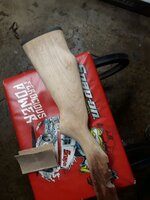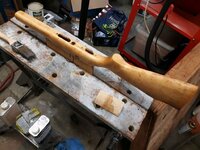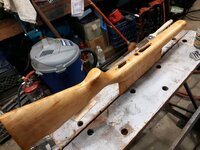Staff Member
Platinum Supporter
- Messages
- 9,715
- Reactions
- 15,414
Upon @Spitpatch 's nudging, I picked up this Marlin a couple of weeks before Christmas. I bought it for my rapidly growing grandson, which was the generational note Spitpatch's remarks were geared to... Christmas was very close. The kid's presents already purchased and wrapped. Lucky for my grandson, his birthday is in January. 
Like a lot of 22s, this one had been tossed around and neglected some. Multiple chips in the finish of the stock, small patches of rust on the barrel and action.

First I went to work on the wood with stripper. Either my stripper sucked (old), or the finish was made of concrete.

Concrete was the logical explanation. I started sanding.


Then I sanded some more...
a lot more.


In the last two pictures show how it's darker around the butt and has little splotches throughout the stock. Didn't know how badly those were going to stand out when the finish was applied.
Years ago I refinished a Savage for my godson. I used Teakwood oil and loved the color.

So, in my infinite wisdom, I used the same stuff. It didn't even come close to looking the same...


While the wood in the Savage came alive, the Marlin looks like a hunk of firewood.
Hmmm... It needs to be darker, much darker.
I've also started stripping the barreled action down to remove rust and refinish.
I'll post more pics of the progression soon.
Like a lot of 22s, this one had been tossed around and neglected some. Multiple chips in the finish of the stock, small patches of rust on the barrel and action.

First I went to work on the wood with stripper. Either my stripper sucked (old), or the finish was made of concrete.

Concrete was the logical explanation. I started sanding.


Then I sanded some more...
a lot more.


In the last two pictures show how it's darker around the butt and has little splotches throughout the stock. Didn't know how badly those were going to stand out when the finish was applied.
Years ago I refinished a Savage for my godson. I used Teakwood oil and loved the color.

So, in my infinite wisdom, I used the same stuff. It didn't even come close to looking the same...


While the wood in the Savage came alive, the Marlin looks like a hunk of firewood.
Hmmm... It needs to be darker, much darker.
I've also started stripping the barreled action down to remove rust and refinish.
I'll post more pics of the progression soon.
Last Edited:














